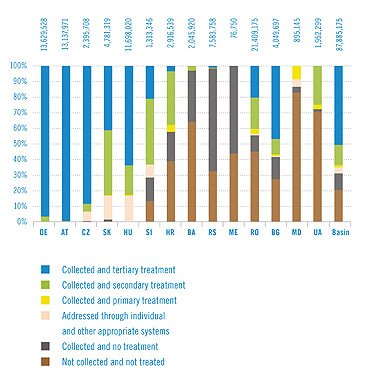Danube Watch 1/2016 - Wastewater treatment in the Danube Basin: a successful but still unfinished story
Wastewater treatment in the Danube Basin: a successful but still unfinished story
Untreated wastewater discharges from households and industry continue to threaten ecosystems in the basin.

Construction of urban wastewater treatment plants and upgrades to wastewater treatment technologies have contributed to a significant decrease in surface water pollution.
© Alexander Haiden / BMFLUW
More than 10 million m3 of wastewater is generated by the citizens and industrial activities connected to sewers in the Danube Basin each day. If not properly treated, wastewater discharges can pose serious threats to the aquatic environment. Untreated wastewater contains organic material, nutrients and hazardous substances in high concentrations whose discharges can negatively affect water quality of the recipient water bodies.
The primary impact of organic pollution on the aquatic environment is dissolved oxygen depletion due to the biochemical decomposition of organic matter. It can also be associated with health hazards due to possible microbiological contamination of waters. Impacts on water status caused by nutrient pollution can be recognised through substantial changes in water ecosystems. In the case of nutrient enrichment, water bodies can enter a eutrophic state where the growth of algae or macrophytes is substantially accelerated. Depending on their concentration and the actual environmental conditions, hazardous substances can cause acute (immediate) or chronic (latent) toxicity. Some of the hazardous substances are persistent and slowly degradable, and can accumulate in the ecosystem.
Unbalanced development of wastewater infrastructure. Households and sewer-connected industry produce a total wastewater load of 88 million population equivalents (PE) at agglomerations above 2000 PE in the Danube River Basin (DRB). Most (72%) of this impressive load is now conveyed to urban wastewater treatment plants or treated individually. Ten percent of the total load is collected but then discharged directly into surface waters without appropriate treatment, whilst the rest is not collected, or treated but directly infiltrated into soil or released to water. The collection and treatment of wastewater is highly enhanced in the upstream countries and at good conditions in some countries in the middle-basin, however in the downstream states significant proportions of the generated loads are either not collected or are collected but not treated.
According to the assessments of the Danube River Basin Management Plan (DRBM Plan) – Update 2015 the basin-wide surface water emissions via wastewater discharges for the reference year 2011/12 total up to 255,000 tons Biochemical Oxygen Demand (BOD) per year. At the basin-wide scale, 88,000 tons per year Total Nitrogen (TN) and 12,000 tons per year Total Phosphorus (TP) are emitted into the surface waters from the wastewater collection and treatment facilities. A significant fraction (BOD: 68%, TN: 31%, TP: 43%) of these emissions stems from agglomerations without appropriate systems for wastewater treatment. The information that is available for hazardous substances emissions is rather scarce. Heavy metals, halogenated organic compounds, phenols, chlorides, cyanides and fluorides are the most relevant compounds with reported releases from treatment plants.
Progress achieved but huge investments still needed. Substantial amounts have been invested in the wastewater infrastructure in the last decade, e.g. more than €6 billion were allocated to infrastructure projects in the field of wastewater in the EU Member States of the DRB for the programme period 2007–2013. Construction of urban wastewater treatment plants and upgrades to wastewater treatment technologies have contributed to a significant decrease in surface water pollution. By 2015, wastewater collection and treatment infrastructure were improved at almost 900 agglomerations. Since the reference year (2005/06) of the first DRBM Plan, the BOD emissions via wastewater have been reduced by almost 50%. The recently reported figures on nutrient point source emissions are significantly lower than those of the first DRBM Plan: TN and TP discharges declined by 32% and 45%, respectively.
Despite the huge investments already made, additional measures should be taken in the future to further reduce point source pollution. Twenty-nine percent of the total PE of the basin needs basic infrastructural development aiming to achieve connection to public sewer systems and at least biological treatment. Wastewater treatment for 28 million PE at agglomerations above 10,000 PE should be further improved by introducing nutrient removal technology. In the EU Member States these measures are in line with the requirements of the EU Urban Wastewater Treatment Directive. Non EU Member States also intend to make efforts to achieve significant improvements by constructing a specific number of sewer systems and wastewater treatment plants by 2021.
Further efforts should be made in the next management cycle (2016–2021) to foster the development of investment projects in the wastewater sector. Supporting non EU Member States to find appropriate financial sources and to achieve better efficiency in wastewater management is still a challenge in the DRB and should be further facilitated. According to the baseline scenario, by 2021 about 14.5 million PE will be connected to treatment plants and almost 16 million PE will be connected to upgraded treatment technology. This would lead to a further decrease in pollution via urban wastewater discharges by 36% (BOD), 10% (TN) and 17% (TP). There is a strong need to close knowledge gaps on hazardous substances emissions in order to better understand what substances are released from wastewater treatment plants to water bodies and what additional measures might be needed to control them.
Share of the collection and treatment stages in the total population equivalents in the Danube countries
(reference year: 2011/2012, absolute numbers on the top refer to PE)







